|
|
Ohan Oda, PhD
Candidate
Department of Computer Science
Computer Graphics and User Interfaces Lab
Columbia University
Office: 212.939.7101
Email: ohan@cs.columbia.edu
|
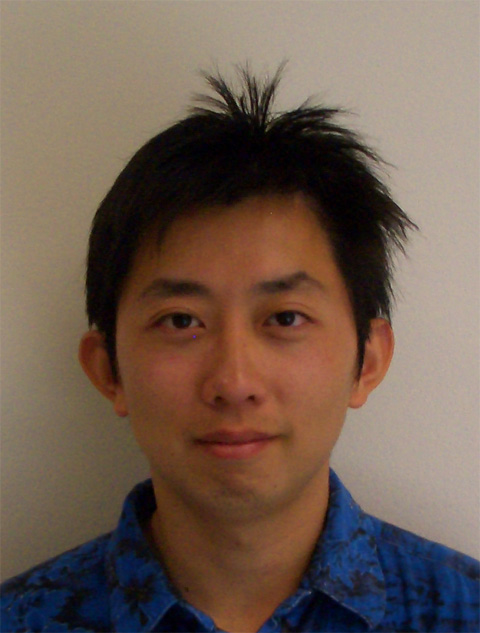 |
|
 |
|
|
Research
|
Publications
|
Teaching
|
Classes
|
Resume
|
|
 |
|
| I'm a Ph.D candidate in Computer Science and a member of the
Computer Graphics and User Interface Lab.
I'm expecting to graduate by the end of 2011.
I'm currently developing the Goblin XNA
infrastructure, which is a platform for research on 3D user interfaces, including augmented reality
and virtual reality, with an emphasis on games. It is written in C# and based on the Microsoft
XNA Game Studio 3.1. The framework is downloadable from
here. I'm broadly interested in applications of mobile
augmented reality systems in the field of recreation and entertainment, including virtual sports and gaming.
My thesis topic is Multi-user Interaction Techniques in Augmented Reality.
I received a B.S. in Computer Engineering and Computer Science from University of Wisconsin Madison
and an M.S. in Computer Science from Columbia.
|
|
 |
|
| Research |
|
 |
|
|
 Fall 2006 - current, CGUI Lab, Columbia University
Fall 2006 - current, CGUI Lab, Columbia University
Developing Goblin XNA,
a platform for building 3D augmented reality games and user interfaces, based on Microsoft XNA.
Goblin XNA is being used for research and teaching
Some projects done using Goblin XNA
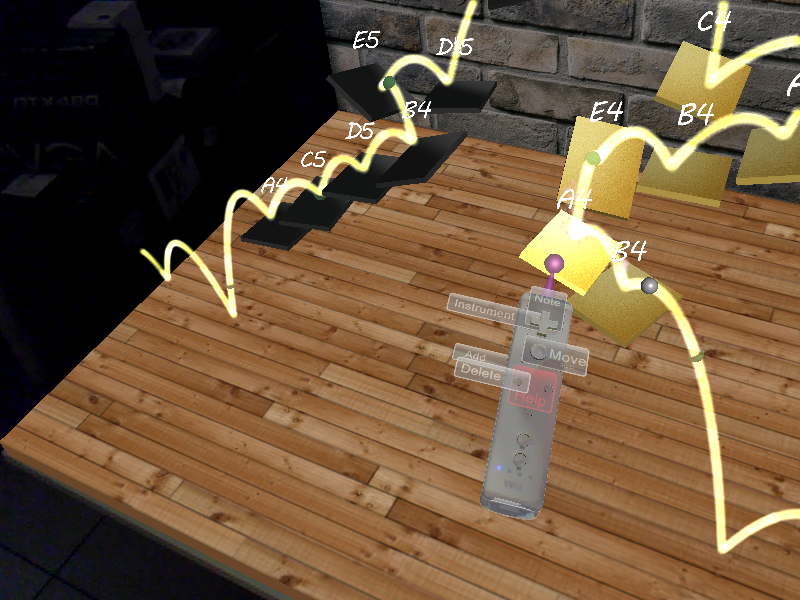
|
Augmented Reality Collaborative Sonic Environment:
This is a 3D audiovisual augmented reality environment
in which players can position and edit virtual bars that
play sounds when struck by virtual balls launched under the
influence of physics. Players experience ARmonica
through head-tracked head-worn displays and tracked handheld
ultramobile personal computers, and interact through
tracked Wii remotes and touch-screen taps. The goal is for
players to collaborate in the creation and editing of an
evolving sonic environment. Research challenges include
supporting walk-up usability without sacrificing deeper
functionality.
A video is available here.
|
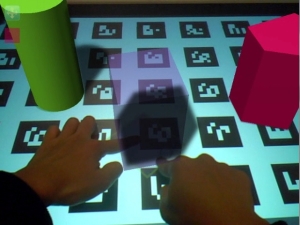
|
Augmented Reality Modeling on Microsoft Surface:
This is an augmented reality application built with Microsoft Surface to
allow the users to directly create and manipulate 3D geometries using their
fingers on the surface. The current version only supports creation of
simple 3D shapes such as cubes, cylinders, and extruded polygons, and displays
the 2D footprints on the surface for observers who are not wearing a head-worn
display.
A video is available here
|
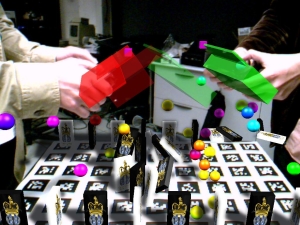
|
Redirected Motion with Multiplayer Domino Game:
In a multi-user augmented reality application for a shared physical environment,
it is possible for users to interfere with each other. For example, consider a
multi-player game in which each player holds a display whose tracked position and
orientation affect the outcome. In this kind of game, one player may physically
block another player's view or physically contact another player. We are exploring
software techniques intended to avoid such interference. These techniques modify
what a user sees or hears, and what interaction capabilities they have, when their
display gets too close to another user's display. Redirected Motion is an effective,
yet nondistracting interference avoidance technique for hand-held AR. For details,
please read the paper here.
A video is available here.
|
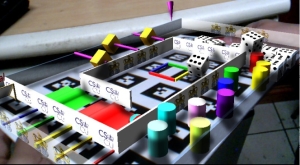
|
Augmented Reality Marble Game:
The player wears a video-see-through head-worn display, and tilts and translates
a tracked board to guide a virtual "marble" (actually, more like a little rubber ball)
through a dynamic maze of obstacles. Gravity in the game always points in the correct
direction, no matter how the player's head and board are oriented relative to each
other. This is possible because the game uses both optical marker tracking and a
separate head-tracker built into the head-worn display. The optical marker tracker
relies on a camera on the head-worn display to determine the board's relative position
and orientation. The built-in head tracker determines which way is "down," which the
game uses, in turn, to compute the true "down" direction for the board.
A video is available here.
|
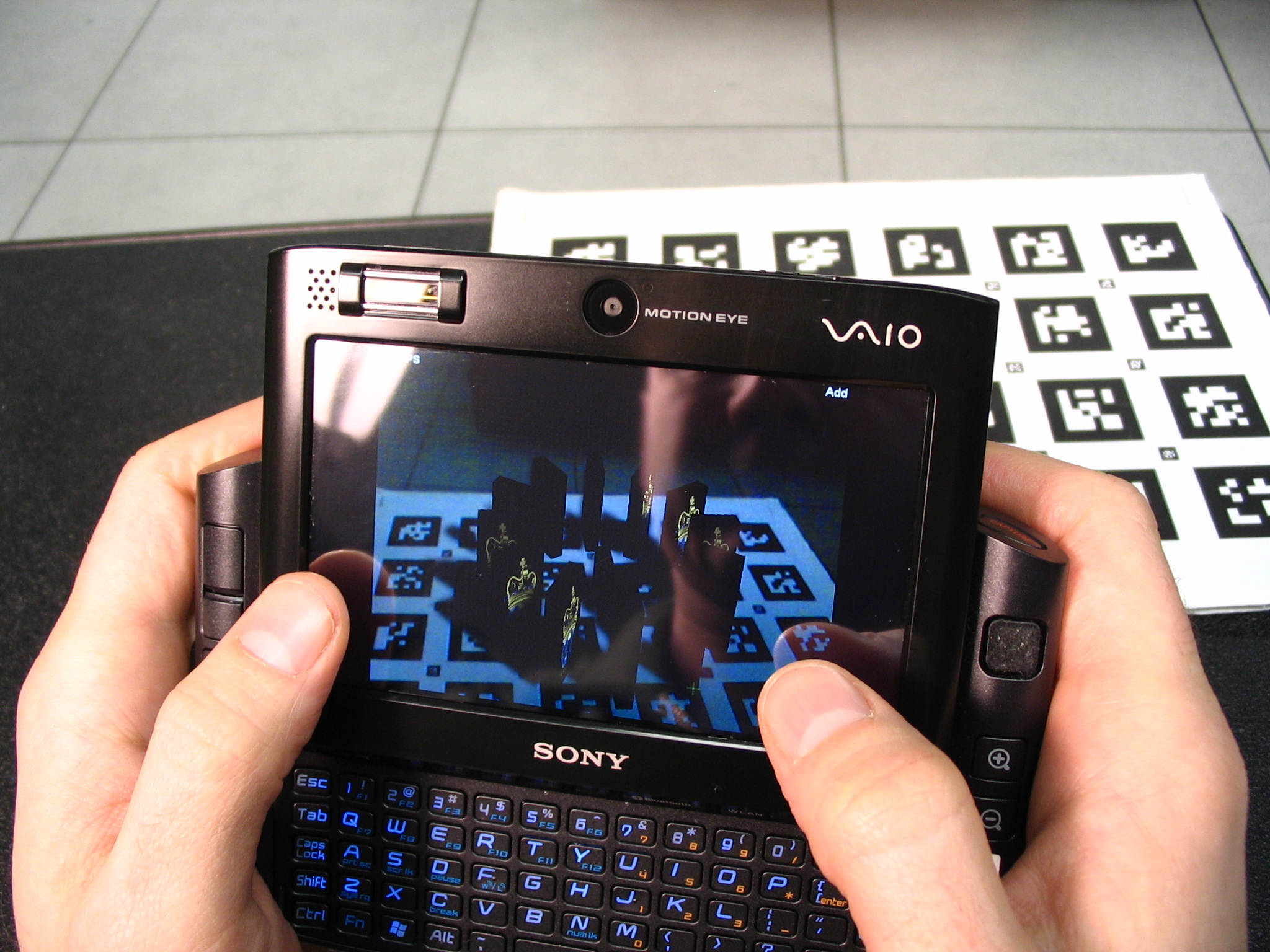
|
Augmented Reality Dominos:
This is an augmented reality domino game. It demonstrates an application that can
run on a mobile device with reasonable framerates (~30Hz without shadows, ~15Hz with shadows).
The player can add more dominos to the optically tracked game board, as well as modify the
position and orientation of each existing domino. The current goal of the game is to knock all the
dominos off the board by shooting balls from wherever the screen is tapped.
|
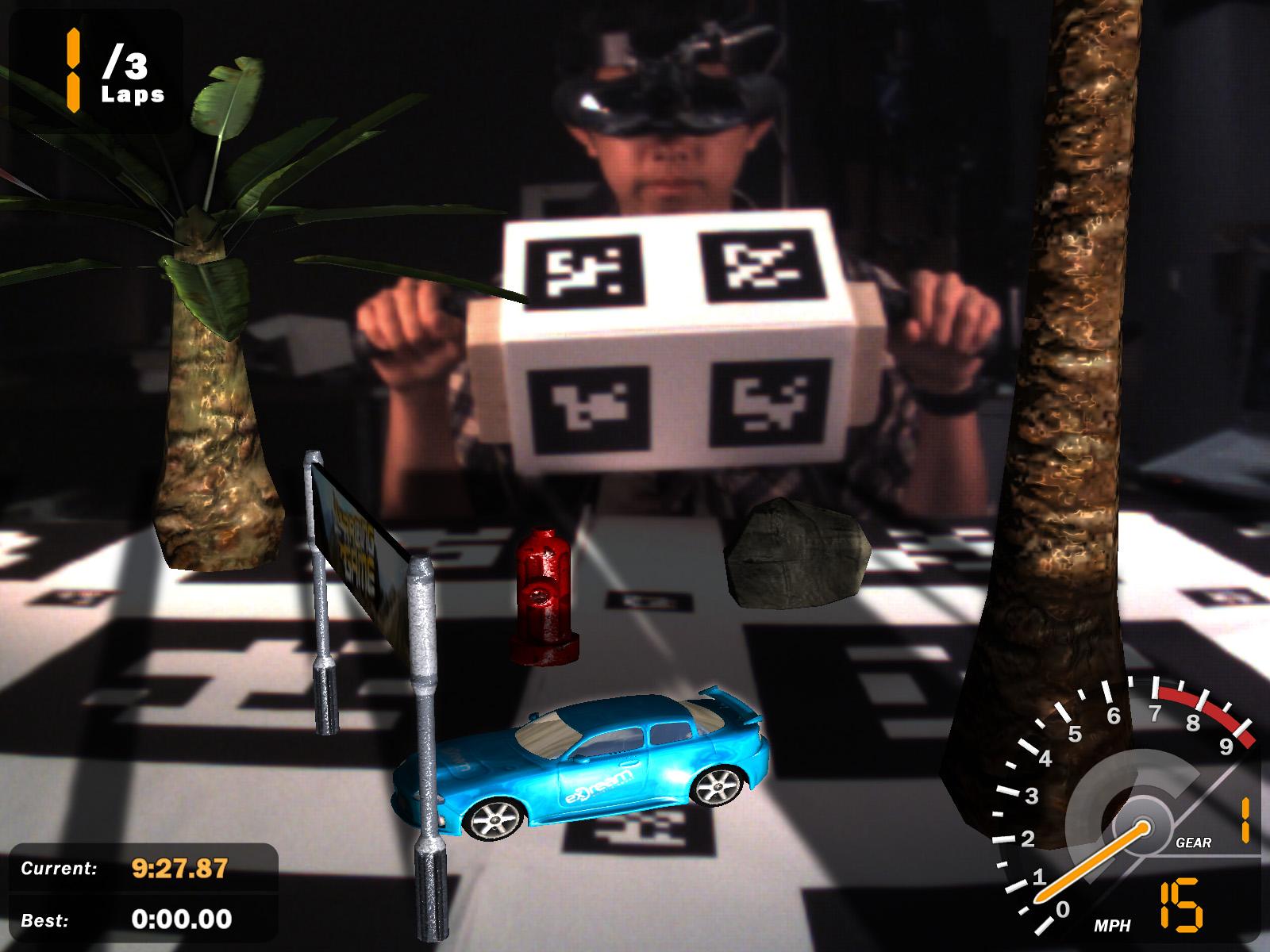
|
Augmented Reality Racing Game:
This is an augmented reality mod of the
XNA Racing Game Starter Kit.
This is the first game being created using Goblin XNA, and demonstrates the
use of fiducial tracking, 2.5D and 3D widgets, and assorted 3D user interface
techniques. The Goblin XNA AR Racing Game uses an optically tracked physical
gameboard, controller, and tokens. Instead of racing around a preset virtual
track, the driver must pass a sequence of waypoints, while avoiding obstacles.
Waypoints and obstacles are attached to physical tokens that can be moved
dynamically during gameplay to rearrange the course.
A video is available here.
|
 Fall 2005 - Spring 2006, CGUI Lab, Columbia University
Fall 2005 - Spring 2006, CGUI Lab, Columbia University
Worked on the implementation of a mobile augmented reality treasure hunt game, as well
as a mobile authoring tool for augmented reality.
Supervisor: Sinem Guven
|
|
 |
|
| Publications |
|
 |
|
|
 Ohan Oda, Steven Feiner, "Rolling and Shooting: Two Augmented Reality Games",
CHI EA '10, Atlanta Georgia USA, 10 - 15 April, 2010.
Ohan Oda, Steven Feiner, "Rolling and Shooting: Two Augmented Reality Games",
CHI EA '10, Atlanta Georgia USA, 10 - 15 April, 2010.
 Ohan Oda, Steven Feiner, "Interference Avoidance in Multi-User Hand-Held
Augmented Reality", ISMAR '09, Florida Orlando USA, pp. 13 - 22, 19 - 22 October, 2009. PDF
Ohan Oda, Steven Feiner, "Interference Avoidance in Multi-User Hand-Held
Augmented Reality", ISMAR '09, Florida Orlando USA, pp. 13 - 22, 19 - 22 October, 2009. PDF
 Sinem Guven, Ohan Oda, Mark Podlaseck, Harry Stavropoulos, Sai Kolluri Gopal Pingali,
"Social Mobile Augmented Reality for Retail",
Percom '09, pp. 1 - 3, 9 - 13 March, 2009.
Sinem Guven, Ohan Oda, Mark Podlaseck, Harry Stavropoulos, Sai Kolluri Gopal Pingali,
"Social Mobile Augmented Reality for Retail",
Percom '09, pp. 1 - 3, 9 - 13 March, 2009.
 Ohan Oda, Levi Lister, Sean White, Steven Feiner, "Developing an Augmented Reality Racing
Game", INTETAIN '08, Cancun, Mexico, 8 - 10 January, 2008. PDF
Ohan Oda, Levi Lister, Sean White, Steven Feiner, "Developing an Augmented Reality Racing
Game", INTETAIN '08, Cancun, Mexico, 8 - 10 January, 2008. PDF
 Ohan Oda, Neesha Subramaniam, "Fast Dynamic Fracture of Brittle Objects in
3D", SIGGRAPH '06, Boston, MA, 29 July - 3 August, 2006
Ohan Oda, Neesha Subramaniam, "Fast Dynamic Fracture of Brittle Objects in
3D", SIGGRAPH '06, Boston, MA, 29 July - 3 August, 2006
 Sinem Guven, Steven Feiner, Ohan Oda, "Mobile Augmented Reality Interaction Techniques
for Authoring Situated Media On-Site", IEEE ISMAR '06, Apr, 2006
Sinem Guven, Steven Feiner, Ohan Oda, "Mobile Augmented Reality Interaction Techniques
for Authoring Situated Media On-Site", IEEE ISMAR '06, Apr, 2006
 Ohan Oda, Stephen Chenney, "Fast Dynamic Fracture of Brittle Objects",
SIGGRAPH '05, Los Angeles, CA, 31 July - 4 August, 2005
Ohan Oda, Stephen Chenney, "Fast Dynamic Fracture of Brittle Objects",
SIGGRAPH '05, Los Angeles, CA, 31 July - 4 August, 2005
|
|
 |
|
| Teaching |
|
 |
|
|
 Spring 2008, Columbia University
Spring 2008, Columbia University
COMS 4172: 3D User Interface, Professor. Steven Feiner
 Spring 2007, Columbia University
Spring 2007, Columbia University
COMS 4172: 3D User Interface, Professor. Steven Feiner
 Spring 2006, Columbia University
Spring 2006, Columbia University
COMS 1007: Object-oriented programming and design in Java
Professor. Sholomo Hershkop
 Fall 2005, Columbia University
Fall 2005, Columbia University
COMS 3827: Fundamentals of Computer Systems
Professor. Prabhakar Kudva
|
|
 |
|
| Classes |
|
 |
|
|
 Fall 2008, Columbia University
Fall 2008, Columbia University
- COMS 4701: Artificial Intelligence, Professor. Alexander Pasik
 Fall 2007, Columbia University
Fall 2007, Columbia University
- COMS 4444: Programming & Problem Solving, Professor. Kenneth Ross
 Spring 2007, Columbia University
Spring 2007, Columbia University
- COMS 4118: Operating Systems I, Professor. Henning Schulzrinne
- COMS 4735: Visual Interfaces to Computer, Professor. John Kender
 Fall 2006, Columbia University
Fall 2006, Columbia University
- COMS 4170: User Interface, Professor. Steven Feiner
- COMS 4231: Analysis of Algorithms, Professor. Mihalis Yannakakis
- KORN 1101: Elementary Korean, TA. Eunyoung Won
 Spring 2006, Columbia University
Spring 2006, Columbia University
- COMS 4162: Programming Languages and Translators, Professor. Stephen Edwards
- COMS 4995: Video Game Design, Instructor. Bernard Yee
- COMS 4901: Projects in Computer Science, Professor. Stephen Edwards
- COMS 6901: Projects in Computer Science, Professor. Steven Feiner
 Fall 2005, Columbia University
Fall 2005, Columbia University
- COMS 4115: Programming Languages and Translators, Professor. Stephen Edwards
- COMS 4150: Computer Graphics, Professor. Ravi Ramamoorthi
- COMS 4824: Computer Architecture, Professor. Luca Carloni
- COMS 6901: Projects in Computer Science, Professor. Steven Feiner
|
|






